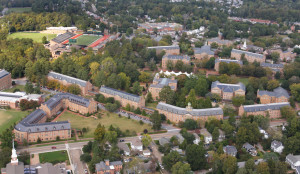At 2:41 p.m. on Feb. 24, the College of William and Mary’s Emergency Management Team issued a campus-wide alarm urging people to seek shelter on the lowest floor of the building they were in at the time.
The EMT was responding to the National Weather Service’s report of a tornado in the Williamsburg area. As a result, students and their professors descended to the lowest floors of their respective buildings. Professors in classes that were already on the ground floor continued teaching.
As the student body reacted to this warning, the first of its kind in several years, the EMT was monitoring the storm. The warning provided an opportunity for the EMT to observe how people on campus reacted to their various updates and revealed any ways in which they could modify their mass communication strategy.
“We did not have a drill,” EMT Coordinator Kenton Towner said. “We had a real situation. It looked like we could have experienced a tornado. We were very concerned.”
Preceding the message that told people to seek low ground, the EMT sent an email at 2:12 p.m. reporting that the school was under a tornado watch. When storms develop in the area, administrators stay alert for information from the NWS.
The College released a take-shelter notice, which can be announced with or without a siren, on the basis of the NWS’ reports. In the case of this recent event, a siren alerted the campus community. The EMT continued to track the progress of the storm as students and faculty moved to basements.
“We’re constantly surveilling the weather,” Towner said. “The NWS is our primary provider of info about severe weather. They’re the authority. They’re the experts.”
We’re constantly surveilling the weather. The NWS is our primary provider of info about severe weather. They’re the authority. They’re the experts,” Towner said.
The College of William and Mary Police Department also plays an important role in such weather emergencies. Chief of Police Deborah Cheesebro said the police began monitoring the weather very early in the day on Feb. 24 and provided frequent updates to Chair of the Emergency Management Team Sam Jones.
Cheesebro is a member of the EMT and oversees the EMT Coordinator position. However, all campus police officers are trained in using the emergency notification system.
Cheesebro noted that, after such warnings, the EMT collects community feedback in the effort to improve response protocols.
“Overall, the community took the warning very seriously and we commend our students, faculty and staff for prioritizing personal safety,” Cheesebro said in an email. “It is critical to heed these warnings and be absolutely certain the threat has passed before leaving shelter.”
While no one was harmed during the event, the EMT noticed certain areas for improvement in their communication processes. Students who lined basement halls waiting for the storm to lift went on their phones. Many of these students, in addition to sending Snapchats of their take-shelter scenario, searched the progress of the tornado on their devices. When they saw that certain online sources determined the severe weather had passed, they exited their respective buildings, regardless of the fact the College had not yet sent an all-clear message.
Jones stated he and his fellow members of the EMT are working on ways to streamline and clarify the communication process. He said that the school itself will send an “all-clear” message indicating when it is once again safe for students and staff to move freely about campus.
“One thing we noted was that in our initial message to take shelter we should be clearer about the fact that we will be issuing an ‘all clear’ once the NWS has lifted its warning,” Jones said in an email. “While students, faculty, and staff can check the NWS and other weather sites on their phones [and] computers, the ‘all clear’ should come from the university.”
Towner corroborated this statement, saying the College would send out a message confirming safety on campus in the event of another warning. He said that, as the EMT was tracking the reports of the NWS on the day of the alert, students also followed the weather via their mobile devices.
“There were lots of people looking at a lot of different information sources,” Towner said. “[Those who left buildings] weren’t being absent-minded. They were using the last word. We want to be the last word.”
One of the most populated buildings during the warning was Earl Gregg Swem Library. The supervising librarians had received training on what to do in the event of a tornado and issued an announcement over the library’s intercom system as soon as the alert was released. The librarians then began to usher students into the basement.
Jeannise Sarvay ’17 was working at the library’s circulation desk during the alert. After the librarians made the announcement over the intercom, she was sent to the basement because she is a student employed at the library. Sarvay’s supervisors continued to direct people as she joined her fellow students.
“We are prepared for every disaster, natural or manmade,” Sarvay said.
We are prepared for every disaster, natural or manmade,” Sarvay said.
Towner mentioned the EMT has trained people who work in heavily-populated buildings, such as the librarians on what to do in the event of a weather emergency. He said the people in charge of Swem are familiar with the procedures.
However, he said training professors how to react in the event of a warning is another challenge. He stated that communicating to professors how to handle an alarm in a certain building can sometimes be difficult.
“Their offices are usually not in the places they teach,” Towner said. “That’s of course going to change every semester. There are a lot of obstacles to total awareness.”

